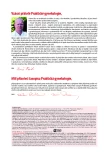Pharmacological options to reduce blood loss in laparoscopic myectomy
Authors:
Miroslav Ščerba
Authors‘ workplace:
Gynekologicko-porodnické oddělení Nemocnice ve Frýdku-Místku, p. o.
Published in:
Prakt Gyn 2013; 17(4): 297-300
Category:
Gynecology and Obstetrics: Review Article
Overview
Bleeding during hysterotomy is one of peroperational complications of laparoscopic myomectomy. It is possible to pharmacologically reduce the risk of blood loss during laparoscopic myomectomy. The thesis compares the available data about the usage of the individual medicaments, their effects and the risks associated with their application. The medicaments used for the reduction of blood loss can be divided according to the period of their usage into three following groups: the ones with preoperational, peroperational, and post-operational usage. Preoperational pharmacological preparation of GnRH analogy can suppress the extension of myomatosis so as to make laparoscopic access possible, but at the same time it does not reduce the blood loss as such with women indicated for laparoscopic myomectomy. Better results are brought by preoperational preparation of SPRM, the effect of which is more selective and more long-lasting in comparison with GnRH and which do not arouse so much of the undesired hyaline degeneration of myoms, which complicates their laparoscopic enucleation, as the GnRH analogues do. The peroperational usage of vasopresin is an effective method of reducing blood loss, which is, though, associated with the risk of serious cardiovascular complications. A clinically safer medicament from the group of vasoconstrictors is epinephrine. When tempered with water at the ratio of 1 : 200,000, epinephrine in combination with a local anaesthetic does not only reduce blood loss but also the length of the operation and post-surgical pain. Uterotonics are used during all phases of operational treatment of myomatosis, including immediate pharmacological preoperational preparation (e. g. by means of misoprostol). So far, though, the proof of their effect has been based on empiricism rather than on the results of thorough and prospective studies.
Key words:
epinephrine – GnRH-analogues – laparoscopic myectomy – misoprostol – vasopressin
Sources
1. Krajčovičová R, Hudeček R. Vliv děložní myomatózy na reprodukční funkce. Prakt Gyn 2010, 14(4): 154–163.
2. Hudeček R, Ivanová Z, Šmedrdová M et al. Vliv aplikace GnRH analog na peroperační a postoperační výsledky myomektomie u žen v reprodukčním věku. Čes Gyn 2012; 77(2): 109–117.
3. Horák P, Mára M, Dundr P et al. Effect of a selective progesterone receptor modulator on induction of apoptosis in uterine fibroids in vivo. Int J Endocrinol 2012; 2012: 436174
4. Kalogiannidis I, Xiromeritis P, Prapas N et al. Intravaginal misoprostol reduces intraoperative blood loss in minimally invasive myomectomy: a randomized clinical trial. Clin Exp Obstet Gynecol 2011; 38(1): 46–49.
5. Shokeir T, Shalaby H, Nabil H et al. Reducing blood loss at abdominal myomectomy with preoperative use of dinoprostone intravaginal suppository: a randomized placebo-controlled pilot study. Eur J Obstet Gynecol Reprod Biol 2013; 166(1): 61–64.
6. Kongnyuy EJ, Wiysonge CS. Interventions to reduce haemorrhage during myomectomy for fibroids. Cochrane Database Syst Rev 2011 Nov 9. DOI: 10.1002/14651858.CD005355.pub4.
7. Nezhat F, Admon D, Nezhat CH et al. Life-threatening hypotension after vasopressin injection during operative laparoscopy, followed by uneventful repeat laparoscopy. J Am Assoc Gynecol Laparosc 1994; 2(1): 83–86.
8. Hobo R, Netsu S, Koyasu Y et al. Bradycardia and cardiac arrest caused by intramyometrial injection of vasopressin during a laparoscopically assisted myomectomy. Obstet Gynecol 2009; 113(2 Pt 2): 484–486.
9. Tulandi T, Béique F, Kimia M. Pulmonary edema: a complication of local injection of vasopressin at laparoscopy. Fertil Steril 1996; 66(3): 478–480.
10. Zullo F, Palomba S, Corea D et al. Bupivacaine plus epinephrine for laparoscopic myomectomy: a randomized placebo-controlled trial. Obstet Gynecol 2004; 104(2): 243–249.
11. Agostini A, Ronda I, Franchi F et al. Oxytocin during myomectomy: a randomized study. Eur J Obstet Gynecol Reprod Biol 2005; 118(2): 235–238.
Labels
Paediatric gynaecology Gynaecology and obstetrics Reproduction medicineArticle was published in
Practical Gynecology

2013 Issue 4
Most read in this issue
- Stillbirth – persistent problem of perinatal care
- Risk of thrombosis in association with oral contraceptive use from hematologist΄s point of view
- Obstetrical anesthesia – Czech Republic versus world
- Principles and results of National register of assisted reproduction
